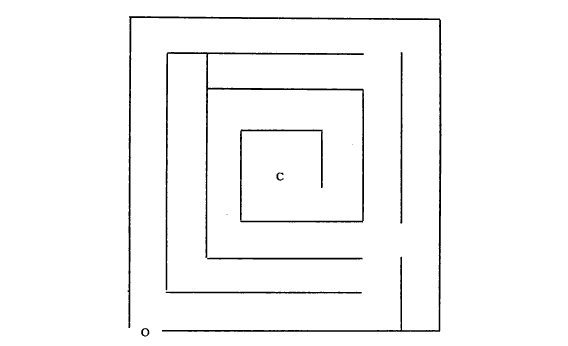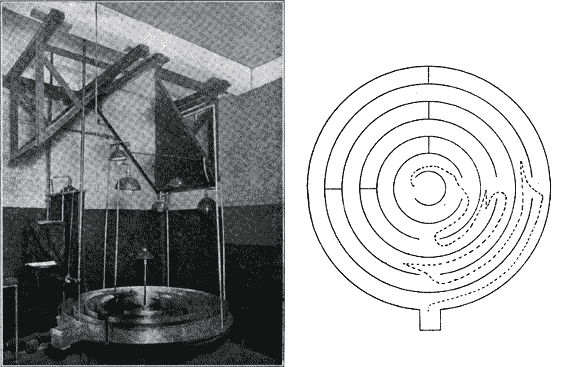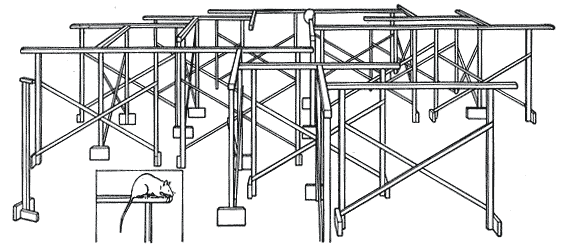

The End of the Maze
How the rodent labyrinth fell out of favor.
Drop a mouse in some water and white paint, and it will know just what to do. Mice can swim, by whipping their tails like a flagellum, but they don't like doing it; a mouse in a tub tries to find a way out. There's no need for training, or food pellets, or annoying electric shocks: To put a mouse through a water maze, you need only to build a little platform for it, hidden somewhere just beneath the surface. The mouse will try to find that platform without any encouragement.
It's a setup that's so simple—and so useful in measuring an animal's capacity for learning and memory—it hardly seems like it would need inventing. But it took a cognitive neuroscientist at the University of St. Andrews in Scotland to come up with the tub-and-platform method. In 1979, Richard Morris built a heated pool about 4 feet and 3 inches in diameter, filled it with water and fresh milk, and then added a platform made of stones and drain piping. Within a few years, his method (designed for rats) had been adapted for smaller lab mice, and had made its way into rodent labs around the world. Now it's among the most widespread animal-testing protocols in all of biomedicine. Scientists plunge mice in murky water to test the effects of brain damage, or the functions of particular genes on learning, or the efficacy of new drugs for treating Alzheimer's. You can even buy a standard-issue "Morris Water Maze" direct from a lab-supply shop, along with specialized software for recording its results.
That fact that so few of us would call a tub full of milk a “maze” only goes to show that rodent mazes aren't what they used to be. Early psychologists tempted rats with tricky blind alleys and wrong turns using contraptions built by hand, of wood and wire. The modern analogs of these devices—the standard rodent mazes of today—come in a few pared-down, elementary forms, pressed from plastic and sold in bulk: A tub, a circle, a plus-sign, a T-shape. The classic implement of behavioral psychology has grown ever less convoluted since it was first invented—less intricate, less mazy. Instead of hoping to lose a rodent in a labyrinth, today's scientists try to elicit a few simple behaviors that can be measured in simple ways. How long did it take the mouse to find the platform? Did he go left or right at the fork?
Traditional mazes take a long time to learn, says Jacqueline Crawley, a mouse behavior expert at the National Institute of Mental Health. (Her friends call her "Mrs. Frisby.") If you want to increase your throughput and generate more data, you're better off with a standard rig. "There are no motivation issues in the water maze,” she explains. You simply drop an animal in the tub a few times per day, over the span of about a week, "and then you’re done.” To run a mouse through a custom-made labyrinth full of twists and turns might take many weeks of training and produce results that can't easily be compared to those from other labs. The classic, elaborated maze that ruled the lab for half the 20th century has grown as outdated as a phonograph. What happened?
The history of the labyrinth falls in line with the history of lab rodents: Both got their start in the early 1900s and had become standard research tools by the end of the 1930s. Still, the earliest navigational puzzles were built for simpler animals. For his 1882 book on Ants, Bees and Wasps, a polymath named John Lubbock constructed simple animal mazes using objects from around the house. He tested whether Hymenopterans could negotiate obstacles like a pencil, a China cup, and a hat box. Eventually, he devised a wooden table made from rotating discs, to see how they would confuse his lines of marching ants.

Rats made their way into the research lab at the turn of the century, starting with a group of researchers in Chicago and at Clark University in Worcester, Mass. A graduate student at Clark named Willard Small was the first to use a rodent maze to study learning. In 1901, he published the details of his new contraption: A platform about 6 feet long by 8 feet wide, covered with sawdust, and divided into galleries with walls of wire netting. He took the plan from a diagram of the hedge maze at Hampton Court, with an open space at the center, and six cul-de-sacs. The layout was selected with a natural setting in mind, he wrote, so that his experiments would be "couched in a familiar language" of rodent burrows.

Small released his animals into the maze every evening, two at a time, by sliding open a glass door with a pulley as if it were a palace portcullis. Then he'd observe the animals for a while, recording their every sniff and sojourn in his notebook, before leaving them to wander the maze for the rest of the night. His 1901 paper includes extravagantly detailed accounts of each run through the maze, with its turning points described in numerical or alphabetic shorthand:
B first out. Directly to 2, pause—a very human-like indecision. After 5 or 6 abortive starts each way, finally entered 2 and proceeded slowly to end. Turned and swiftly retraced his steps. At mouth of 2 joined by A. Together they proceeded placidly to end of 3. Turned instantly and galloped back swiftly out of 3, not slowing up until e. Here B, charmed by the odor from C, stopped to dig. A, forward soberly, hesitated at x turning now right, now left, but finally on to n …
The Hampton Court maze, designed to resemble both a rat's wild habitat and the carefully trimmed shrubbery of a British castle, became a neat metaphor for the taming of woolly Nature in the lab. Soon other researchers adapted Small's method with varying degrees of success. In 1902, A.J. Kinnaman put a pair of rhesus monkeys in a 17-foot-wide version of the same maze. A few years later, James Porter tried running some English sparrows and a female cowbird through the setup before resorting to a dumbed-down version with fewer blind alleys.

This new approach to psychology moved in strange directions. In October 1911, a graduate student at the University of Chicago named Fleming Perrin began testing his professors and colleagues in a local amusement-park attraction called the "Mouse-trap." He blindfolded each subject with a band of black silk and set them loose in a 45-foot-wide, duodecagonal maze while he watched from a catwalk. "The subjects became so engrossed in the search for openings," he wrote, "that a few unlooked for bodily contacts with the ends of blind passages resulted."

Attempts to run non-rodents through mazes were short-lived. Soon the rat became the standard animal in psychology, and the maze was the standard apparatus for the rat. One crucial innovation came from a young psychologist named James B. Watson, who for his dissertation sent rodents through a Hampton Court maze while under various degrees of sensory deprivation: Some rats he blinded; others he deafened; still others had their whiskers plucked or their paws covered over. The animals could navigate by "chain reflex" alone, he found—a kinesthetic sense of how to reach the food at the center. For one famous study, known as the "kerplunk" experiment, he altered the maze slightly after the rats had learned it. The animals were so accustomed to the original layout that they ran smack into the wall, kerplunk.

Watson moved on from the Hampton Court layout to a circular maze of his own design, with concentric, interconnected passages. Lamps hung over the setup and researchers could track and trace the paths of their rodents by means of a camera lucida. Through a series of experiments conducted on this and other mazes, he developed a theory of behavior that recognized "no dividing line between man and brute." You could learn everything you might want to know about human psychology, he suggested, from the behavior of rats in a maze.
A golden age of labyrinths soon followed. The psychologists John Connors and Richard E. Brown describe this period in an exhaustive, unpublished paper on the history of the rodent maze. A vast array of new designs made their way into the literature: Walter R. Miles, for example, perfected the elevated trestle maze—a precursor to more simple, modern variants like the Elevated Plus Maze—in his garage near Stanford University. Rats raced around an open structure that resembled a railroad bridge or roller coaster, impelled toward their goal by a fear of heights. The new design made it easier to observe the rats' movements, and the maze could be collapsed for storage.

Back at Clark University, Walter S. Hunter came up with a maze that looked like an M. C. Escher drawing: the Double-Alternation Tridimensional Spatial Maze. Rats had to navigate an upward spiral that required repeating right-right and left-left turns. This setup proved extremely difficult to learn (at least for blinded animals with their whiskers plucked): Just six of the 23 rats tested learned to make it through without an error.

The golden age of maze-building would soon come to an end, however. In the 1920s, the psychologist B.F. Skinner put rats through mazes as many of his colleagues did, but by the end of the following decade his faith in the method had waned. He began testing rats and pigeons in a bare-bones, lever-pressing apparatus. As Skinner's influence grew over the next few decades, conventional maze research fell into decline. Psychologists turned their attention toward the study of reinforcement schedules and stimulus-response relationships that could be measured without having to build a double-alternating, tridimensional spiral.

In the 1940s, what mazes remained were often reduced to simpler forms, such as the T-maze or the Y-maze, in which an animal has only one choice to make—left or right. The pared-down, binary layout was more amenable to statistical analysis, and it may have resonated with the developing science of information theory. At a conference on cybernetics in 1951, the father of that field, Claude Shannon, presented his own, newfangled version of the rodent maze. His lab animal was an electronic rat named "Theseus," which used some rudimentary rules of machine learning to navigate a walled grid like a Roomba.

Some new, unfussy mazes (for live rodents) emerged in the late-1970s, including the Barnes Maze, which consisted only of a circular platform, 4 feet in diameter, with a series of holes drilled along its perimeter—like an oversized View-Master reel laid flat. The design took advantage of a rat or mouse's tendency to seek shelter from brightly lit, open spaces. An animal placed at the center of the maze checks out each hole until it finds one that leads to the safety of a dark, enclosed box. It's a task that's simple enough for mice (which tend to be a little duller than rats), and, like the Morris Water Maze, it doesn't require any electric shocks or dietary inducements.
The elaborated maze had nearly gone extinct. As mice started to replace rats for laboratory experiments in the 1980s and 1990s, rodent mazes grew even more standardized and simplified. The Barnes Maze, along with a few others—the Morris Water Maze, the Radial Maze, the Elevated Plus, the Elevated Zero, and the Y- and the T-Maze—became ubiquitous.
In 2009, a molecular biologist and physicist from Princeton named David Tank introduced the next major step in the evolution of maze research. His setup includes no walls or passageways, no platforms or tubs of water. Instead, he clamps the heads of his Black-6 mice in place and leaves their paws free to skitter across the surface of an 8-inch Styrofoam sphere suspended on a cushion of air. It works like a giant trackball, which the mouse can use to maneuver through a virtual maze (built using software from the video game Quake II) that's projected onto a video screen.
Want to see some awesome mazes? Check out Mazes To Amaze by Yonatan Frimer - Tarquin Publications These are some of the most incredible mazes of optical illusions that you'll see in your life.
